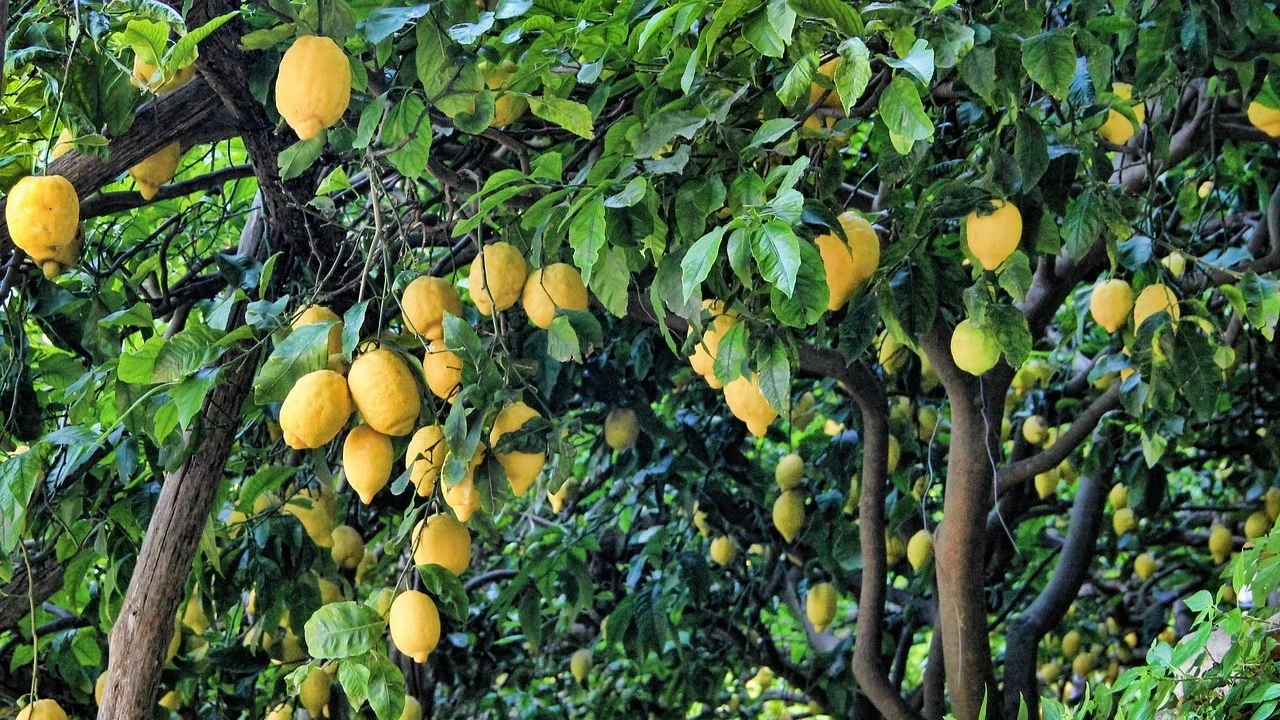Lemon trees are a beloved addition to any home garden due to their attractive appearance, fragrant blossoms, and delicious fruit. However, lemon tree care is essential to ensure your tree grows strong and produces high-quality fruit year after year. Whether you’re planting your lemon tree in a garden or growing it indoors in a pot, this comprehensive guide will cover every aspect of lemon tree from climate requirements and planting to watering, fertilizing, pruning, and pest management. With the right approach to lemon tree care, you can enjoy a thriving lemon tree that yields fresh lemons for many seasons.
Summary of Key Takeaways
- Climate and Soil: Lemon tree requires a warm, sunny climate and well-draining soil with a slightly acidic pH between 5.5 and 6.5.
- Watering: Effective lemon tree care involves deep, infrequent watering to encourage healthy root development and prevent root rot.
- Fertilization: Regular feeding with nitrogen-rich fertilizer is crucial in lemon tree care to promote strong growth and fruit production.
- Pruning: Pruning is a key part of lemon tree care, as it improves air circulation, encourages sunlight exposure, and maintains a healthy shape.
- Pests and Diseases: Common pests in lemon tree care include aphids, spider mites, and citrus leaf miners, which can be controlled with organic treatments.
- Indoor vs Outdoor Care: Lemon tree care varies based on whether your tree is grown indoors or outdoors, with indoor trees needing more attention to light and humidity.
- Harvesting: Lemons are typically ready for harvest 6-9 months after flowering, and proper lemon tree care ensures the fruit is flavorful and abundant.
The Best Climate for Lemon Tree Care
Understanding the ideal climate for lemon tree care is the first step in ensuring healthy growth and fruit production. Lemon trees are native to subtropical and tropical regions, meaning they thrive in warm environments.
- Temperature Requirements: For optimal lemon tree care, lemon trees grow best in temperatures between 50°F and 85°F (10°C to 29°C). They are sensitive to cold temperatures, and frost can severely damage or even kill the tree. It is important to protect your tree from frost during the winter months, which is why many gardeners in colder climates grow their lemon trees in containers that can be moved indoors.
- Frost Protection: A key element of lemon tree care in colder regions is frost protection. If you live in an area prone to frost, covering your lemon tree with frost blankets or moving it indoors when temperatures drop is crucial. For in-ground trees, planting near a south-facing wall can provide some protection from cold winds.
- Humidity and Wind: Lemon trees prefer moderate humidity levels, making humidity management a part of proper lemon tree care. In very dry climates, misting the tree or using a humidifier can help maintain moisture. Additionally, protecting your lemon tree from strong winds is important, as high winds can damage the branches and knock off developing fruits.
- Best Growing Zones: Lemon trees are best suited for USDA hardiness zones 9-11. In these regions, lemon trees can be grown outdoors year-round. For colder zones, lemon tree care will involve either growing the tree indoors or providing additional protection during winter.
| USDA Zone | Temperature Range (°F) | Lemon Tree Suitability |
|---|---|---|
| 9 | 20-30°F | Suitable with frost protection |
| 10 | 30-40°F | Ideal |
| 11 | 40-50°F | Perfect for year-round growth |
In colder zones, lemon tree care often involves container gardening to allow for easy indoor movement during cold seasons.

How to Plant Lemon Trees: The Foundation of Lemon Tree Care
Planting your lemon tree correctly is crucial for establishing a healthy tree that will thrive for years. Whether you are planting your tree outdoors or in a container, following proper lemon tree care guidelines from the start is essential.
- Choosing the Right Location:
- For successful lemon tree care, choose a location with plenty of sunlight. Lemon trees need at least 6-8 hours of direct sunlight each day to grow and produce fruit.
- Spacing: If planting your tree in the ground, ensure that you leave adequate space between trees—around 10-15 feet for standard-sized trees and 6-8 feet for dwarf varieties. Proper spacing allows for good air circulation, which is a key aspect of lemon tree care to prevent disease.
- Soil Requirements:
- Lemon tree requires soil that is well-drained and slightly acidic, with a pH level between 5.5 and 6.5. Before planting, improve the soil with organic matter such as compost or aged manure to boost fertility and drainage.
- Soil Testing: Test the soil pH before planting. If the soil is too alkaline, you can add sulfur to lower the pH. For overly acidic soil, lime can be added to raise the pH.
- Planting in Containers:
- When growing lemon trees in containers, choose a pot that is at least 18-24 inches in diameter and has drainage holes at the bottom. Proper lemon tree care for container trees includes ensuring that excess water can drain out to prevent root rot.
- Soil Mix for Containers: Use a well-draining potting mix designed for citrus trees, or create your own by mixing one part sand, one part loam, and one part organic compost.
| Planting Option | Pros | Cons |
|---|---|---|
| In Pots | Easy to move indoors, ideal for small spaces | Requires frequent watering and attention |
| In Ground | Allows for larger trees and higher yields | Vulnerable to environmental factors |
Proper planting is the foundation of successful lemon tree care, setting your tree up for healthy growth and fruit production.

How to Water Lemon Trees for Healthy Lemon Tree Care
Watering is one of the most critical aspects of lemon tree care. Both underwatering and overwatering can lead to problems, so it’s important to strike the right balance.
- Outdoor Watering:
- Outdoor lemon trees need deep watering but not too frequently. For effective lemon tree care, water your tree deeply once every 1-2 weeks. This ensures that water reaches the deep roots and encourages the tree to develop a strong root system.
- Overwatering Warning: Avoid overwatering, as waterlogged soil can lead to root rot, a common problem in lemon tree care. Always allow the top 2-3 inches of soil to dry out between waterings.
- Indoor Watering:
- Indoor Lemon Tree Care: When growing lemon trees indoors, it’s crucial to water them whenever the top 2-3 inches of soil feel dry. Indoor trees in containers tend to dry out more quickly, so regular checks are necessary. Proper lemon tree care for indoor trees also includes misting the leaves to maintain humidity, especially during the winter months when indoor air tends to be dry.
- Mulching for Moisture Retention: Applying mulch around the base of your outdoor lemon tree is a useful technique for moisture retention. Mulching helps to keep the soil moist, regulates temperature, and can also suppress weeds.
| Watering Schedule | Frequency | Best Time to Water |
|---|---|---|
| Outdoor Trees | Every 1-2 weeks | Morning (before noon) |
| Indoor Trees | When topsoil dries | Morning or early afternoon |
Proper watering practices are fundamental to effective lemon tree care and will ensure your tree remains healthy and strong throughout its life.
Fertilizing Lemon Trees: A Crucial Part of Lemon Tree Care
Fertilizing is another important aspect of lemon tree care, as lemon trees are heavy feeders and require regular nutrients to support their growth and fruit production.
- Choosing the Right Fertilizer:
- Use a nitrogen-rich fertilizer designed for citrus trees. A fertilizer with an NPK ratio of 6-3-3 or similar works well for lemon tree care because it provides the nutrients necessary for healthy foliage growth, flowering, and fruiting.
- Organic fertilizers such as compost, manure, or fish emulsion are also excellent choices for lemon tree care, as they improve soil structure and release nutrients slowly over time.
- Fertilizing Schedule:
- During the growing season, apply fertilizer every 4-6 weeks as part of regular lemon tree care. Start fertilizing in the spring when new growth begins, and continue through summer. Reduce fertilization during the fall and winter months when the tree’s growth slows down.
- Container-grown lemon trees may require more frequent feeding since nutrients can leach out of the soil with each watering.
- Signs of Nutrient Deficiency:
- If your lemon tree’s leaves start to yellow, it may be a sign of nutrient deficiency, particularly nitrogen deficiency. Regular fertilization is a crucial part of lemon tree care to prevent such issues.
| Fertilizer Type | Pros | Cons |
|---|---|---|
| Organic | Enhances soil health naturally | Slower nutrient release |
| Synthetic | Quick results, easy to use | May lead to salt buildup in soil |
Fertilizing regularly is a key component of successful lemon tree care that ensures your tree receives the nutrients it needs for robust growth and abundant fruit production.

Pruning Lemon Trees for Healthy Lemon Tree Care
Pruning is an essential part of lemon tree care, as it helps maintain the shape of your tree, improves air circulation, and encourages better fruit production.
- When to Prune:
- The best time to prune lemon trees is in late winter or early spring, before the tree enters its active growing season. This timing allows the tree to heal quickly and promotes new growth.
- Pruning during the growing season is acceptable for removing dead or diseased branches, which is an essential practice in lemon tree care to prevent the spread of diseases.
- How to Prune:
- Removing Dead or Diseased Branches: One of the most important steps in lemon tree care is removing dead or damaged branches. This not only improves the tree’s appearance but also prevents the spread of disease.
- Thinning Out Dense Growth: Lemon trees can become crowded, which restricts sunlight and air from reaching the inner branches. Thinning out dense areas of growth is a key part of proper lemon tree care to ensure good air circulation and reduce the risk of fungal diseases.
- Shaping the Tree: Shaping your lemon tree helps maintain its size, especially if grown in a container. Regular pruning for shaping purposes is an important part of lemon tree care for keeping the tree manageable and promoting better fruit yield.
| Pruning Tips | Benefits |
|---|---|
| Remove dead branches | Prevents disease and promotes healthy growth |
| Thin dense branches | Improves air circulation and sunlight exposure |
| Shape the tree | Maintains a compact, manageable size for containers |
Pruning should be an integral part of your lemon tree care routine, as it helps keep your tree healthy, attractive, and productive.
Common Pests and Diseases in Lemon Tree Care
Lemon trees are susceptible to various pests and diseases that can damage the tree and affect fruit production. Managing these issues is a key part of effective lemon tree care.
- Common Pests:
- Aphids: Aphids are small insects that feed on the sap of new growth, causing leaves to curl and stunting the tree’s development. To protect your tree, use organic treatments like neem oil, which is a staple in lemon tree care for controlling aphids.
- Spider Mites: Spider mites cause yellow speckles on leaves and can lead to leaf drop if not treated. Regularly misting your tree can help deter spider mites, as they thrive in dry conditions.
- Citrus Leaf Miner: Citrus leaf miners tunnel through the leaves, leaving behind silver trails and distorted growth. Removing affected leaves is a crucial part of lemon tree care when dealing with this pest.
- Common Diseases:
- Root Rot: Overwatering is one of the leading causes of root rot, a serious condition that can kill your tree. Preventing overwatering and ensuring proper soil drainage are essential practices in lemon tree care to avoid this disease.
- Citrus Canker: Citrus canker is a bacterial disease that causes raised lesions on leaves and fruit. To manage this disease, prune out infected areas and apply a copper-based fungicide.
| Pest Name | Symptoms | Treatment |
|---|---|---|
| Aphids | Leaf curling, stunted growth | Neem oil, insecticidal soap |
| Spider Mites | Yellow speckles, leaf drop | Increase humidity, spray with water |
| Citrus Leaf Miner | Silver trails on leaves | Remove affected leaves, neem oil |
Managing pests and diseases is an ongoing part of lemon tree care that ensures your tree remains healthy and productive.
For more information on scientific research behind citrus care, visit the University of Florida IFAS Citrus Growing Guide

Growing Lemon Trees Indoors: Specialized Lemon Tree Care
Growing lemon trees indoors requires special attention to lemon tree care practices, especially when it comes to light, watering, and humidity.
- Light Requirements:
- Lemon trees need plenty of sunlight, so if you’re growing them indoors, place them near a south-facing window where they can get at least 8-12 hours of sunlight each day. If natural sunlight is insufficient, consider using a grow light to provide the necessary light for effective lemon tree care.
- Temperature and Humidity:
- Keep indoor temperatures between 60°F and 70°F (15°C to 21°C) for optimal growth. Avoid cold drafts and sudden temperature changes, as lemon trees are sensitive to these conditions.
- Indoor environments can be dry, especially during winter. Misting the leaves or placing a humidifier nearby can help maintain the humidity levels needed for proper lemon tree care indoors.
- Pollination:
- Indoor lemon trees may not receive enough pollination naturally, so hand-pollination may be necessary. Use a small, soft brush to transfer pollen between flowers to help your tree produce fruit.
| Indoor Care Tip | Action |
|---|---|
| Light Requirements | 8-12 hours of sunlight or grow light |
| Watering Frequency | Water when topsoil dries out |
| Pollination | Hand-pollinate if fruiting is insufficient |
Growing lemon trees indoors can be more challenging, but with the right lemon tree care, it’s entirely possible to have a thriving lemon tree that produces fruit year-round.
Where to Buy Lemon Trees and Products
If you’re ready to begin your lemon tree care journey, purchasing a healthy lemon tree from a reputable source is the first step. Consider buying from Hasiru Agro, a trusted supplier of lemon trees.
- Kagzi Lemon Plant: A popular variety for home gardens, known for its juicy, flavorful fruit. It’s perfect for those looking to start lemon tree care.
- Balaji Lemon Plant: A hardy and fast-growing lemon variety, ideal for those who want a vigorous tree that’s easy to care for.
- Kolkata Patti Lemon Plant: This lemon plant produces rich, tangy fruit, perfect for cooking and juicing.
- All Season Lemon Plant: True to its name, this lemon variety bears fruit throughout the year, ensuring a continuous supply of fresh lemons.
- Thai Seedless Lime: For those who enjoy limes, this seedless variety is an excellent choice.
These high-quality plants are available for purchase online and can be delivered straight to your home, making it easy to get started with lemon tree care.

Frequently Asked Questions About Lemon Tree Care
How Long Does It Take for a Lemon Tree to Bear Fruit?
Lemon trees typically take 3-5 years to start producing fruit. However, proper lemon tree care—including regular fertilization, watering, and pest control—can help speed up the process.
Why Are My Lemon Tree Leaves Turning Yellow?
Yellow leaves on a lemon tree can indicate a range of issues, including overwatering, nutrient deficiencies, or poor soil drainage. Testing the soil and adjusting your lemon tree care practices can often resolve this issue.
Can I Grow a Lemon Tree in a Pot?
Yes, lemon trees can thrive in pots with the right lemon tree care. Choose a large container with good drainage, and ensure the tree receives plenty of sunlight and regular watering. Dwarf varieties are especially well-suited for container gardening.
What Should I Do If My Lemon Tree Isn’t Blooming?
If your lemon tree isn’t producing flowers, it may not be receiving enough light or nutrients. Increasing sunlight exposure and ensuring the tree is fertilized regularly are important parts of lemon tree that can encourage flowering.
Conclusion
Proper lemon tree care is the key to growing a healthy, productive lemon tree that will provide you with fresh, delicious lemons for years to come. Whether you’re planting your tree in the ground or in a container, watering, fertilizing, pruning, and managing pests are all critical components of lemon tree care. By following this comprehensive guide, you’ll be well on your way to cultivating a thriving lemon tree that brings beauty and bounty to your home or garden.







